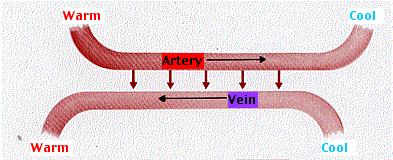Many animals (including humans) have another way to conserve heat. The arteries of our arms and legs run parallel to a set of deep veins. As warm blood passes down the arteries, the blood gives up some of its heat to the colder blood returning from the extremities in these veins.

Such a mechanism is called a countercurrent heat exchanger. When heat loss is no problem, most of the venous blood from the extremities returns through veins located near the surface.
Countercurrent heat exchangers can operate with remarkable efficiency. A sea gull can maintain a normal temperature in its torso while standing with its unprotected feet in freezing water.
When you consider that the blood of fishes passes over the gills which are bathed in the surrounding water, it is easy to see why fishes are "cold-blooded". Nonetheless, some marine fishes (e.g., the tuna) are mesotherms — able to keep their most active swimming muscles warmer than the sea by using a countercurrent heat exchanger.
 This photograph on the right (courtesy of E. D. Stevens, Dept. of Zoology, University of Guelph, Ontario) shows a cross section through a skipjack tuna. The dark muscle on either side of the vertebral column is maintained at a higher temperature than the rest of the fish thanks to its countercurrent heat exchanger.
This photograph on the right (courtesy of E. D. Stevens, Dept. of Zoology, University of Guelph, Ontario) shows a cross section through a skipjack tuna. The dark muscle on either side of the vertebral column is maintained at a higher temperature than the rest of the fish thanks to its countercurrent heat exchanger.
The cold, oxygen-rich arterial blood passes into a series of fine arteries that take the blood into the active muscles. These fine arteries lie side by side with veins draining those muscles. So as the cold blood passes into the muscles, it picks up the heat that had been generated by these muscles and keeps it from being lost to the surroundings.

Thanks to this countercurrent heat exchanger, a tuna swimming in the winter can maintain its active swimming muscles 14°C warmer than the surrounding water.
The photomicrograph on the left (also courtesy of Dr. Stevens) is of a cross section through the heat exchanger. Note the close, parallel packing of the arteries (thick walls) and veins (thin walls).
| Countercurrent exchangers also operate in the kidney and are built into the design of artificial kidneys. |
The circulatory system is also responsible for cooling an animal. If the animal's "core" body temperature gets too high, the blood supply to the surface and extremities is increased enabling heat to be released to the surroundings. If this is insufficient, the animal can evaporate water from the blood — in the form of sweat for those animals with sweat glands. The evaporation of 1 gram of water absorbs some 540 calories of heat.
Most endotherms cannot tolerate a rise in body temperature of more than 5°C or so. The brain is the organ most susceptible to damage by a high temperature. Some mammals, dogs for example, have a countercurrent heat exchanger located between the carotid arteries and the vessels that distribute blood to the brain. This heat exchanger transfers some of the heat of the arterial blood to the relatively cool venous blood returning from the nose and mouth. This cools their arterial blood before it reaches the brain.
The shifting of blood flow as needed to maintain homeothermy is controlled by temperature receptors in the hypothalamus of the brain. One set of receptors here responds to small (0.01°C) increases in the temperature of the blood. When triggered, all the activities by which the body cools itselfA second region of the hypothalamus triggers warming responses:
It is the hypothalamus that executes the fever response. In effect, the hypothalamus is the body's thermostat. The release of prostaglandins during inflammation increases the setting; that is, turns the thermostat "up". If the body temperature is not yet there, the body begins shivering violently — causing "chills" — to generate the heat needed. The result is fever when the new set point is reached.
| Welcome&Next Search |